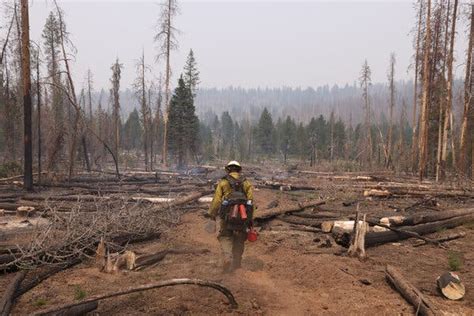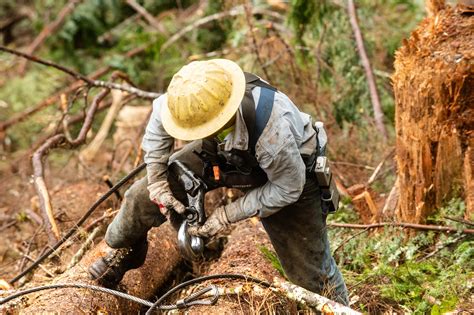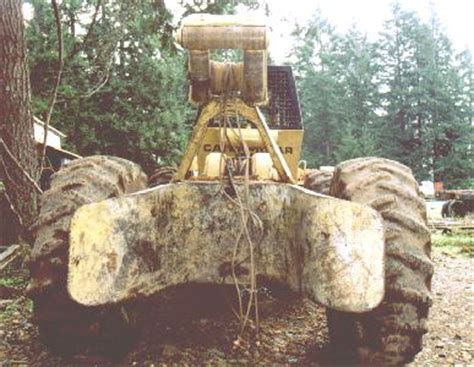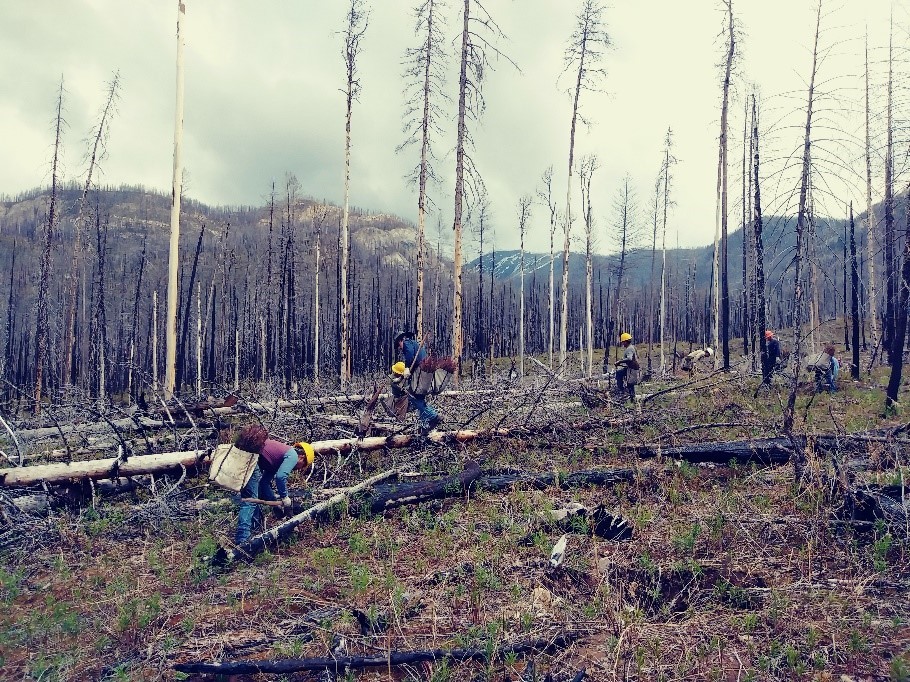Burnt Forest
Spring 1977
Within weeks of my first Spring of residence at the remote hamlet of Colestin, Oregon in the Siskiyou Mountains, I began working for a local four-man logging operation, known as ‘King and Hanscom’. We harvested trees on private land in the region surrounding the Siskiyou Summit, south of Mount Ashland, under the shadow of Pilot Rock. Initially, we logged private timberland owned by “Fruit Growers Supply”, FGS was private forest property encompassing a vast expanse of Northern California. King and Hanscom specialized in ‘salvage logging’, extracting dead and dying timber deep in the back woods, using established roads and trails.

The first months were ‘green logging’. Green trees, green canopy and rich forest floor. As spring turned to summer we commenced working a new site, far down the Klamath River, a two-hour drive from my cabin. This new site was salvage logging of a different sort: post forest fire.
The burnt forest had been locally owned for generations; their forest had not been logged for many decades. The blackened forest consisted of mixed species of ‘second growth’ timber, primarily Ponderosa Pine with some fir and cedar. I observed one (1) first growth log, a hollowed-out shell, likely gutted by rot and ignored long ago. The largest second-growth timber was about thirty-inch diameter, most of it much smaller. No skid trails or roads crossed the burnt forest slope, just six inches of black duff, torched needles.
Within this blackened environment I worked ‘choking’ logs. After the ‘timber cutters’ completed their falling, we crawled the hillsides with a dozer, ours a Caterpillar D6 (one of the toughest). The dozer scraped paths up the easiest grade, first approaching the largest timber.
I rode our ‘Cat’ up-slope in the early light, was dropped among the fallen ‘sticks’, thereafter spent my morning alone amidst the blackened soil and charred logs. My task was to prepare a clutch of appropriate weight logs for the dozer. The ‘cat skinner’ dragged a ‘skid’ to the ‘landing’ while I choked the next clutch from amidst the tangle of logs.
The choking task itself was tough; wrap a 3/4 inch wire rope around a log and cinch the heavy and recalcitrant wire end to a ‘bell’ fitting. Some chokes were simple and easy: the butt of the log extending into the air. Throw the wire over and insert the end into the bell. The ‘wire rope’ itself is a heavy snake with broken strands like thorns and a ‘coiling memory’ from usage that continually resists compliance. Handling that wire can cause the snake to strike back with a spring loaded ‘whack’.

The greatest proportion of logs were smashed into the blacked turf, criss-crossed with sawn-off limbs, and difficult to access. A choker-setter must clear space and get down in the dirt, face to the ground and poke, dig and muscle the choker under the log, near the butt-end. This process was nasty work requiring heavy gloves, leather chaps, durable boots and strong, strong arms.
The mornings were not tough. The cool morning air and indirect sunlight made the choking, working solitary amidst the blackness, relatively peaceful. Following completing a ‘set’, I could take time to gaze at the mountains, the blackness and ponder my existence. The diesel thundering and track clanking of the approaching dozer signaled an end to my brief peace; time to strain.
The dozer would swivel and turn about, aligning the back-end winch ‘in line’ with my selected timber. I stayed clear and well above the jumble of logs and slash, for the dozer is a powerful brute, able to dislodge or rotate a teetering log. The log can swivel or roll once jostled, crushing a person or smashing a leg.
Once stationary and the pounding diesel throttles back to idle, I would skip over the jumble of logs to the winch cable and begin unspooling the heavy wire with a twelve pound hook uphill toward my pre-set choker cables. The winch cable was an even heavier wire, permanently coiled from the constant winding and unspooling.
I muscled the fish-hook toward the chokers and linked up, then skedaddled uphill, always up and apart the dozer, wire and choked logs. Using hand signals to communicate, I motioned ‘clear’; the powerful winch then began tensioning the load. This moment is fraught with danger, the load begins to move, unevenly, often sliding. The dozer strains and wiggles as a choker become taut, first one, then others. Finally, cinching the logs up tight, my clutch of logs begins the crawl down-slope to the landing.
Following a morning of multiple sets and skids, Eddie Hanscom, the owner cat-skinner, would hand signal lunch time (a hand to mouth mimicking ramming a sandwich) about 11 A.M. Now commenced a tough 45 minutes, eating lunch alongside this coarse group. These fellows: log truckers, cutters, cat skinners, loader operators and landing guys; were aware that I had ‘some’ education, and never let me forget that I was on the lowest rung of the logging ladder: choker setter. Any trivial error or slip was an opportunity to question the value of education and promote their ‘real world’ experience. They were however often intrigued by my lunch of ‘hippie food’, including nuts, fruit and whole grains; while they munched baloney on white bread.
The agony of the afternoon heat and dust commenced after lunch. The shadeless black slopes were now churned into airborne dust, tractor treads grinding the burnt forest floor to powder, the dragged logs billowing a dark cloud skyward.
There was no tree canopy, all burnt and gone. The only shade to be found was the long narrow shadow cast by standing dead wood. After evaluating my next skid, I sat at the base of a standing dead tree, in the slender cast of shade cover.
All too soon the D6 would come rumbling upslope, churning and clanking, the blade raised high to avoid stumps. I remained seated, resting, while obscured from the boss’s vision by the high blade. Pride in work would not allow me to remain seated while being paid in front of the boss, so I would spring to my feet just before the cat leveled off, the blade now lowered, revealing that I was standing and ready for work.
The afternoon dragged on, the heat and dust intensifying. The timber cutters ended work at 1:30 in the afternoon, statistics having long ago revealed that accidents are common after six hours of that perilous work. I watched longingly as they descended the hill, knowing three additional hours of strenuous labor still awaited me.
The heat, dust and heavy labor yielded perspiration across my face, chest and arms. The sweat causing the black charcoal dust to attach to my face, neck, arms and clothing. The attached dust left me appearing like a end-of-shift coal miner or a black man. Shoe polish black face. The dust laden perspiration would stream down my face and neck, marking a rivulet down my chest and sternum.
As the final log-truck arrived at our landing, I clambered upon the Cat for a ride downslope. The work so strenuous and heavy I chose to ride the Cat downslope and avoid even the most trivial extra effort. Besides that, this was a dangerous environment.
Ambling along behind the skid of logs, day dreaming, perhaps ten feet behind, I drifted, as I am wont to do. During that unguarded moment a green sapling, one flattened by the dozer and dragged over by the skid, suddenly sprang upright, slamming me in the chest and knocking me backwards to the ground. Stunned, I lay for a moment, then sat up slowly, awakened abruptly from my daydream.
The crew were unsympathetic, ‘shouldn’t walk there behind the skid’, was the boss’s comment. Shook up, I was silent during the long drive back to Colestin that evening. The following week was my last.
The Landing
Spring 1979
Reluctantly, I returned to logging less than two years later. Broke and unwilling to work in food service any longer, I needed a fresh financial ‘stake’ to make change. The years in Southern Oregon were taking a toll on my ability to work labor and sustain myself. I had little choice.
That same year, an investment group purchased the five thousand acre “R Ranch” outside Hilt, California. This was my neighborhood. This new group of ‘Christian loggers’ were intent on squeezing the life from the Ranch through raising cattle, contract grazing, renting every shack and structure, plus timber harvesting.

This logging operation was the bottom of the ladder. Small rubber wheeled ‘skidders’ dragged ‘pecker poles’ of pine, often only twelve to sixteen feet. There is very little commercial lumber in such small timber. Yet Gail Willey, the owner, harvested relentlessly, violating his harvesting permit and common sense.
‘Working the landing’ is the most dangerous job on a ‘logging show’. The landing logger works on foot, carrying a chainsaw, while toiling among the moving dozers, front-end loaders and big-rig trucks. The landing logger must constantly be aware of skidders entering the landing with a fresh clutch of logs, while a front-end loader is picking logs from the skid, stacking a pile and loading onto a big-rig truck. All this big iron is moving in all directions: stopping, starting, honking and yelling amid the ever-present din of diesel engines and howling chainsaws. I now wore ear protectors, leather chaps and full face shield.
The skidder charges into the landing amidst a cloud of dust, leading a skid of logs. Abruptly stopping, the skidder backs-up, relieving tension on the winch, while the dust catches up, enveloping the scene. The landing logger enters the ‘no mans land’ between the skidder and choked logs to unhitch the winch hook. Everything is heavy. Stepping back, the skidder then rumbles off, leaving their dirt caked clutch of logs.
Chainsaw in hand, the landing logger makes sense of the jumbled mess. The logs arrive rough cut with stubby branches, broken ends and varying lengths. I would then commence to walk the logs, removing the cable chokers and ‘bumping’ off stubby knots. Using a loggers spring loaded tape measure dangling from my belt, I measured and bucked each log to eight, twelve and sixteen foot measured lengths. We had no thirty-twos or twenty-fours.
The logs are covered in dirt. I chopped at the bark with axe to remove soil-encrusted bark, performing a final cleaning with the high-pressure exhaust from my saw. Suspending the saw over a dirty cut spot, I revved high to blow dirt away before commencing my cut.
Maintaining my chain saw was a constant undertaking: chain derailment, sharpening, fueling and adjusting. This drill never stopped. I worked to avoid cutting soil and ‘grounding’ my chain, avoiding yet another sharpening, a task performed five or more times daily. One momentary tap on grit with a high speed chain necessitated resharpening.
The skidder drivers came in hot, with little regard (or awareness) for others. ‘Get out of the way’ and ‘watch what you are doing’ was the mantra. There was no concern if they ran into something or scared you.
I developed ‘popeye arms’ and hardened curled hands. There was a time, I put my saw down next to a skid while tending to other work. A cat-skinner came in hot, missing the skid, but mashing the chainsaw. I was blamed and admonished, ‘do not put the saw down’. I was expected to carry the twelve pound beast all day.
Within three months I saved a moderate ‘stake’, by standards of the day.
Soon after, during early summer, I ventured to Alaska for work and adventure. While in Homer, Alaska I endured my final logging experience, cutting spruce for a road ‘right-of-way’. This final experience used all my skills with saws, falling trees working alongside heavy equipment.
Tree Planter
Spring of 1977, 1979
I am a tree planter. I have planted over fifty thousand trees during my lifetime. All but 1,000 were planted commercially, in public and private forest lands, the others placed lovingly on my own properties. The estimate is based on two spring planting seasons, in total about fifty days of back-breaking labor. The goal, and average, each day was one-thousand trees. For this I was paid about 5 cents per tree, yielding a fifty dollar payday.

The tool of the tree planter is a ‘hoe-dad’, an unforgiving combination of hoe and spade with a curved handle similar to an axe. The hoe-dad, like a pick-axe has opposing ends: the sharpened ‘hoe-end’ opposes the elongated ‘spade-end’. The flat steel hoe/spade is coupled to the handle by a heavy collar. The hoe-dad weighs about seven pounds when dry, without encrusted mud.
The planter wears ‘bags’, waterproof vinyl tubs, worn in a bandolier style across chest, one on each side. Each bag can carry hundreds of trees, dependent on the strength of the planter. When loaded, I carried 100 to 150 trees in each bag, weighing fifteen to twenty pounds each.
In all, thirty to forty pounds of trees and a seven pound hoe-dad; heavy boots and leather gloves, all caked with spring mud.
The trees are two and three years old, approximately eighteen to twenty-four inches in total length. Each tree is almost symmetric, with a crown of needles above ground and fan of root strands below ground. The roots are wet and peppered with vermiculite to retain moisture.
The process of forest tree planting is arduous. The tree planter spaces trees ten-to-twelve feet apart. Stepping three paces to the placement spot, my hoe-dad is raised high above the head and swung forcefully down, spade-end impacting the earth. The impact is a jarring moment, especially if the spade impacts a rock or hard soil. The best planters raise with both hands and finish the swing with one arm, releasing their grip at the final moment before impact, thereby avoiding the stinging vibration of impact. Performed a thousand times per day, while not being on of the ‘best planters’, the jolting impact affected all of my body.
Leaving the hoe-dad embedded in the ground, the planter selected a tree and prepared to drop to one knee and place the seedling. With the sharp hoe-end extending upwards, I placed the root fan over the sharpened hoe-end with two hands, severing an inch from the root-ends by sliding over the sharpened edge.
Now with trimmed seedling roots and embedded hoe-dad, the planter must work quickly and deftly, with technique like that of a baker making ‘pie-crust’. Still at ground level on one knee, and grasping the tree at mid-point with left hand, while gripping the hoe-dad with the right, I wiggled my hoe-dad to temporarily create space, then quickly flicked the root-end into the collapsing space, while pulling my hoe-dad from the ground. All one motion: wiggle-flick-lift. The planter times the flick with the wiggle to insert the tree roots, while sliding the hoe-dad away without disturbing the root placement.
Packing the tree becomes the most demanding portion of the process as the day wears on. While still on one knee, the planter is encouraged to punch the soil next to the tree with a gloved fist. (I often skipped this part) The planter must then rise to his feet, with bags and mud, and stomp the soil surrounding the seedling firmly. Without the stomp a seedling dries out prematurely and the roots are not firmly in contact with soil. By the end of the day, stomping becomes painful.
During my commercial planting career I regularly experienced moments of green consciousness. Some hoe-dad penetrations are deep and embedded in moist rich soil. Aha! Here is a home for growth, thinks I. Like all livings entities, there are some seedlings which are larger and more vigorous than others, some double the size and girth, with significant needle growth. My ‘green consciousness’ would take over in such a moment – for I would select one of my better seedlings for such a prime spot. Similarly, a poor planting hole would receive a poor seedling – sometimes two!
The gravest danger in this dance is a dreaded “J-root”! A tree planted too deep, or forced into a shallow hole, will form a ‘J’ at the root base. A J-root causes tree mortality in the second season. The U.S. Forest Service employs inspectors, people who dig-out random samples to ensure quality control. A ‘J-rooter’, a consistently bad planter, is soon unemployed, fired by the forest contractor who is docked contract payment for excess J-roots based on inspected samples.
During spring of 1977 I performed my first commercial tree planting work, placing Ponderosa and Jeffrey Pine in the West Side slope below Sonora Pass. I worked for a ‘forest contractor’, one who bid, and performed contract services for the U.S. Forest Service. The first setting was attractive, rocky cliffs rose above high country meadow. The ground was recently logged and prepared by dozer for planting.
The spring soil was drying quickly, the moisture content low. I was tasked with an additional burden due to the dry soil. The US Forest Service required us to “scalp” the surface before swinging the hoe-dad. A further step repeated hundreds of times each day. Before swinging the hoe-dad I bent over and scraped the ground, removing the top two-three inches of dry soil. An agonizing addition to the process that yielded no additional pay!
Later that season in 1977 we moved into a “burn”. The burn scar was literally 350 thousand acres. We drove for a long stretch to reach our site, traveling on a newly created road, produced exclusively for harvesting the burnt timber. So far back in the woods was our work site that we camped out, avoiding the 2.5 hour one-way drive. As far as the eye could see was a jumble of low brush, tall weeds and enormous burn piles. Following a fire, first is road building, then logging, then slash dozing and piling, followed by pile burning.
The piles must have been small house sized. When I planted, the wildfire had been years earlier; the burnt slash piles perhaps a year previous. The piles were now reduced to a jumble of blackened, partially burnt logs atop a deep heap of ash and soil.
The heaps of ash and soil were known to be fertile. Inspectors required and expected us to plant in, on and within these blackened heaps. There was no ‘nature’. No birds singing or deer alertly chewing; just blackened slash and high weeds, stretching to the horizon. There was nothing natural or inspiring to give pause.
Two years later I was again planting, this time on private forest land owned by Fruit Growers Supply, in Hilt California. This was commercial forest south of my cabin in Colestin, Oregon, near Siskiyou Summit. I planted for one month alongside local hippies and rednecks within this well kept forest.
Memorably, this forest was historic Hopi Indian land. The planter is intimate with the ground, face to the soil, systematically covering an area. The first discovery of an authentic obsidian arrow-head was a eureka moment among the planters. The crew gathered around, oohing and aahhing, with comments like ‘cool’, ‘you’re lucky’. The race to find arrowhead treasures was now commenced in earnest: the biggest, most perfect, sharpest. I found two specimens: a scraper and mid-size arrowhead with broken tip. My brother Larry was incredibly jealous, until he found the largest, most perfect specimen that season.
Christmas Tree Harvesting
Fall 1977
Harvesting wild Christmas Trees on FGS land.
